Logistics Case Study: Tucker Company's Proposal for Bell Oil Refinery
VerifiedAdded on 2023/06/15
|17
|4006
|465
Case Study
AI Summary
This case study examines Tucker Company International's (TCW) proposal to provide logistics services to Bell Oil, a refinery in Readings, Pennsylvania. Mike Mellencamp, carriers sales director at TCW, is tasked with creating a proposal that demonstrates TCW's value, covers all feasible transit options, and aligns with the company's financial practices. The case discusses the pros and cons of hiring a 3PL like TCW, including scalability, cost savings, and potential loss of control. It analyzes factors influencing shipping costs for Bell Oil and presents various shipment options, such as over-the-road transport, rail transport, and barge transport. The study further includes a SWOT analysis, qualitative and quantitative assessments of the situation, and addresses the challenges of meeting client demands for quick, simple, and low-cost solutions. Desklib provides access to similar case studies and solved assignments for students.
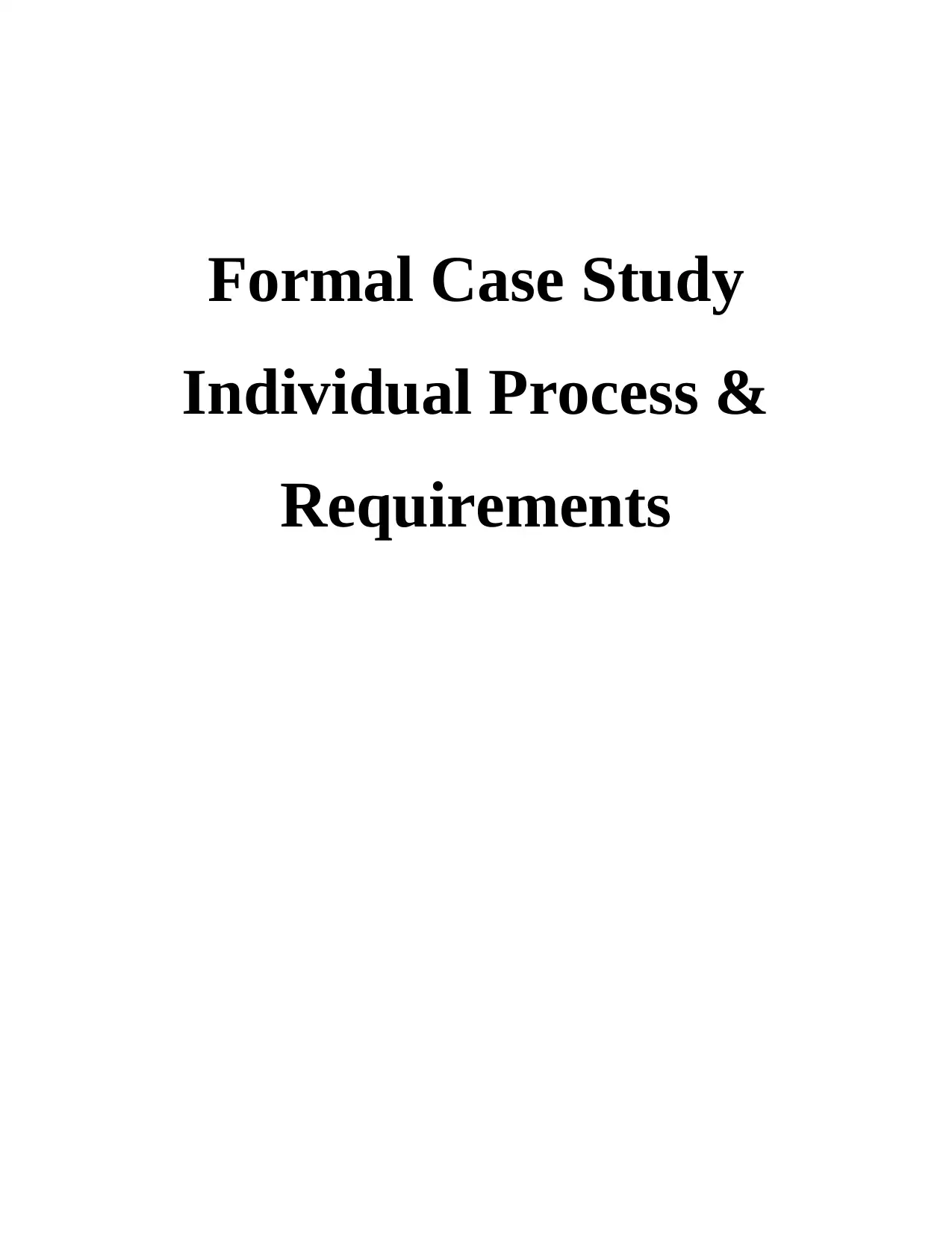
Formal Case Study
Individual Process &
Requirements
Individual Process &
Requirements
Paraphrase This Document
Need a fresh take? Get an instant paraphrase of this document with our AI Paraphraser

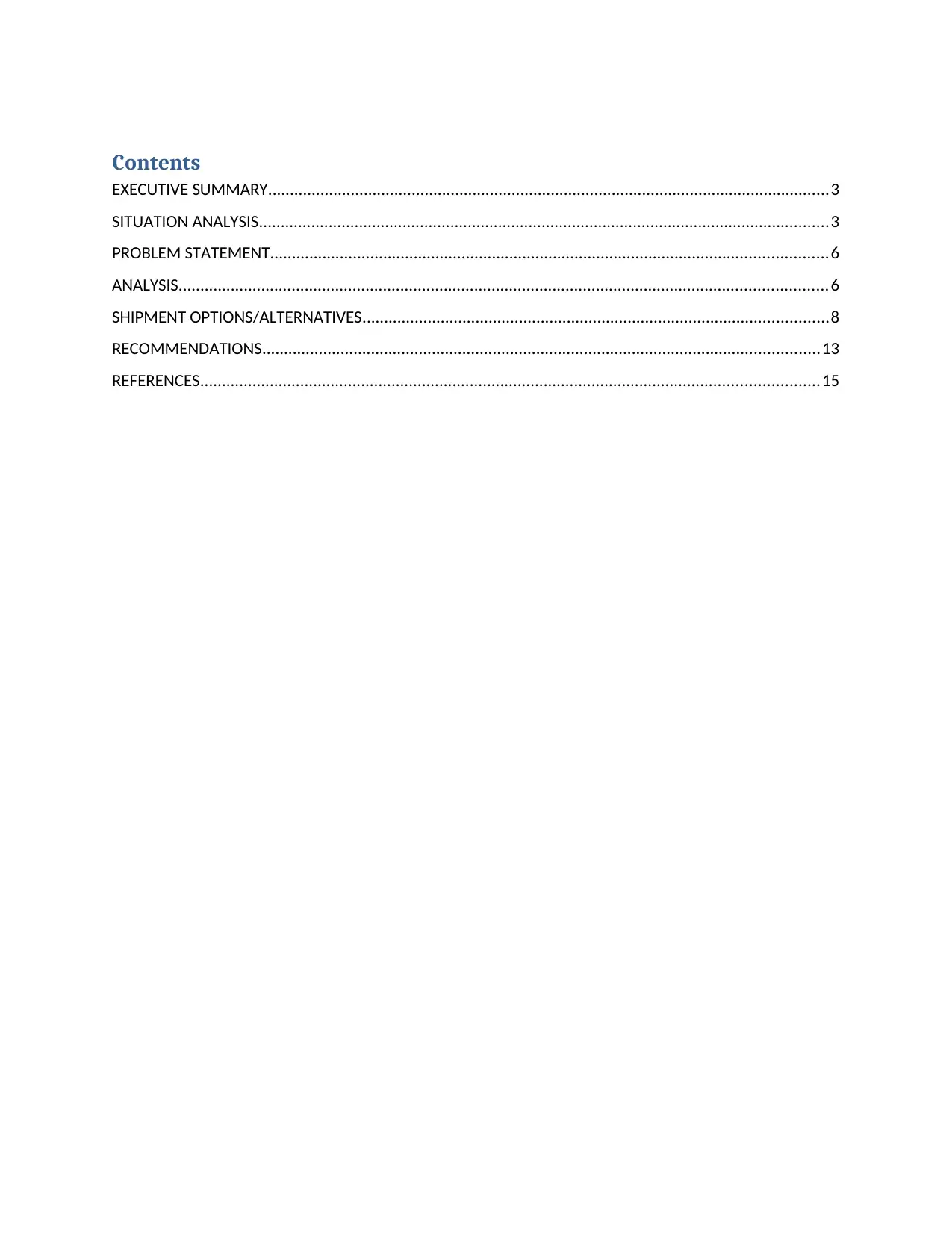
Contents
EXECUTIVE SUMMARY.................................................................................................................................3
SITUATION ANALYSIS...................................................................................................................................3
PROBLEM STATEMENT................................................................................................................................6
ANALYSIS.....................................................................................................................................................6
SHIPMENT OPTIONS/ALTERNATIVES...........................................................................................................8
RECOMMENDATIONS................................................................................................................................13
REFERENCES..............................................................................................................................................15
EXECUTIVE SUMMARY.................................................................................................................................3
SITUATION ANALYSIS...................................................................................................................................3
PROBLEM STATEMENT................................................................................................................................6
ANALYSIS.....................................................................................................................................................6
SHIPMENT OPTIONS/ALTERNATIVES...........................................................................................................8
RECOMMENDATIONS................................................................................................................................13
REFERENCES..............................................................................................................................................15
⊘ This is a preview!⊘
Do you want full access?
Subscribe today to unlock all pages.

Trusted by 1+ million students worldwide
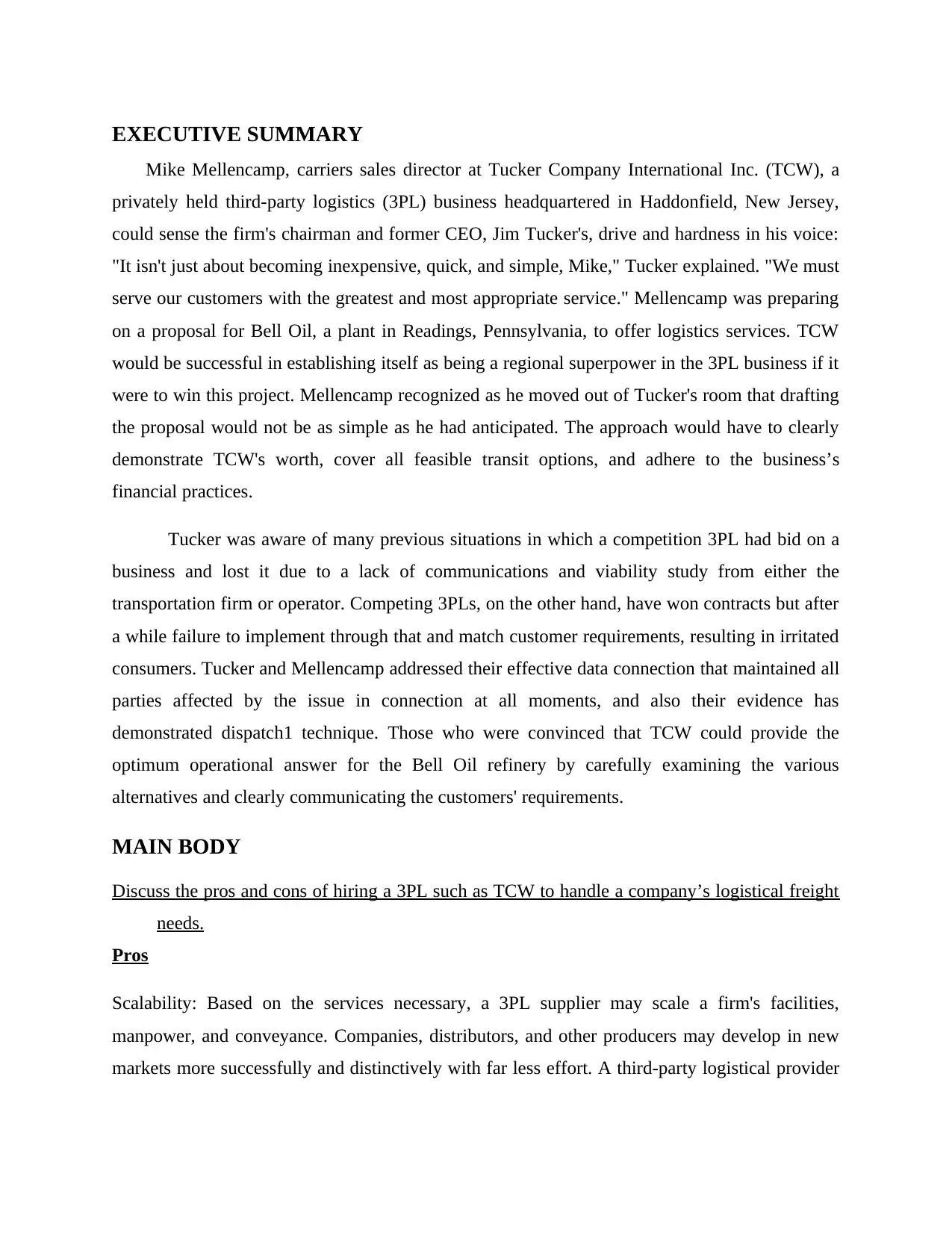
EXECUTIVE SUMMARY
Mike Mellencamp, carriers sales director at Tucker Company International Inc. (TCW), a
privately held third-party logistics (3PL) business headquartered in Haddonfield, New Jersey,
could sense the firm's chairman and former CEO, Jim Tucker's, drive and hardness in his voice:
"It isn't just about becoming inexpensive, quick, and simple, Mike," Tucker explained. "We must
serve our customers with the greatest and most appropriate service." Mellencamp was preparing
on a proposal for Bell Oil, a plant in Readings, Pennsylvania, to offer logistics services. TCW
would be successful in establishing itself as being a regional superpower in the 3PL business if it
were to win this project. Mellencamp recognized as he moved out of Tucker's room that drafting
the proposal would not be as simple as he had anticipated. The approach would have to clearly
demonstrate TCW's worth, cover all feasible transit options, and adhere to the business’s
financial practices.
Tucker was aware of many previous situations in which a competition 3PL had bid on a
business and lost it due to a lack of communications and viability study from either the
transportation firm or operator. Competing 3PLs, on the other hand, have won contracts but after
a while failure to implement through that and match customer requirements, resulting in irritated
consumers. Tucker and Mellencamp addressed their effective data connection that maintained all
parties affected by the issue in connection at all moments, and also their evidence has
demonstrated dispatch1 technique. Those who were convinced that TCW could provide the
optimum operational answer for the Bell Oil refinery by carefully examining the various
alternatives and clearly communicating the customers' requirements.
MAIN BODY
Discuss the pros and cons of hiring a 3PL such as TCW to handle a company’s logistical freight
needs.
Pros
Scalability: Based on the services necessary, a 3PL supplier may scale a firm's facilities,
manpower, and conveyance. Companies, distributors, and other producers may develop in new
markets more successfully and distinctively with far less effort. A third-party logistical provider
Mike Mellencamp, carriers sales director at Tucker Company International Inc. (TCW), a
privately held third-party logistics (3PL) business headquartered in Haddonfield, New Jersey,
could sense the firm's chairman and former CEO, Jim Tucker's, drive and hardness in his voice:
"It isn't just about becoming inexpensive, quick, and simple, Mike," Tucker explained. "We must
serve our customers with the greatest and most appropriate service." Mellencamp was preparing
on a proposal for Bell Oil, a plant in Readings, Pennsylvania, to offer logistics services. TCW
would be successful in establishing itself as being a regional superpower in the 3PL business if it
were to win this project. Mellencamp recognized as he moved out of Tucker's room that drafting
the proposal would not be as simple as he had anticipated. The approach would have to clearly
demonstrate TCW's worth, cover all feasible transit options, and adhere to the business’s
financial practices.
Tucker was aware of many previous situations in which a competition 3PL had bid on a
business and lost it due to a lack of communications and viability study from either the
transportation firm or operator. Competing 3PLs, on the other hand, have won contracts but after
a while failure to implement through that and match customer requirements, resulting in irritated
consumers. Tucker and Mellencamp addressed their effective data connection that maintained all
parties affected by the issue in connection at all moments, and also their evidence has
demonstrated dispatch1 technique. Those who were convinced that TCW could provide the
optimum operational answer for the Bell Oil refinery by carefully examining the various
alternatives and clearly communicating the customers' requirements.
MAIN BODY
Discuss the pros and cons of hiring a 3PL such as TCW to handle a company’s logistical freight
needs.
Pros
Scalability: Based on the services necessary, a 3PL supplier may scale a firm's facilities,
manpower, and conveyance. Companies, distributors, and other producers may develop in new
markets more successfully and distinctively with far less effort. A third-party logistical provider
Paraphrase This Document
Need a fresh take? Get an instant paraphrase of this document with our AI Paraphraser
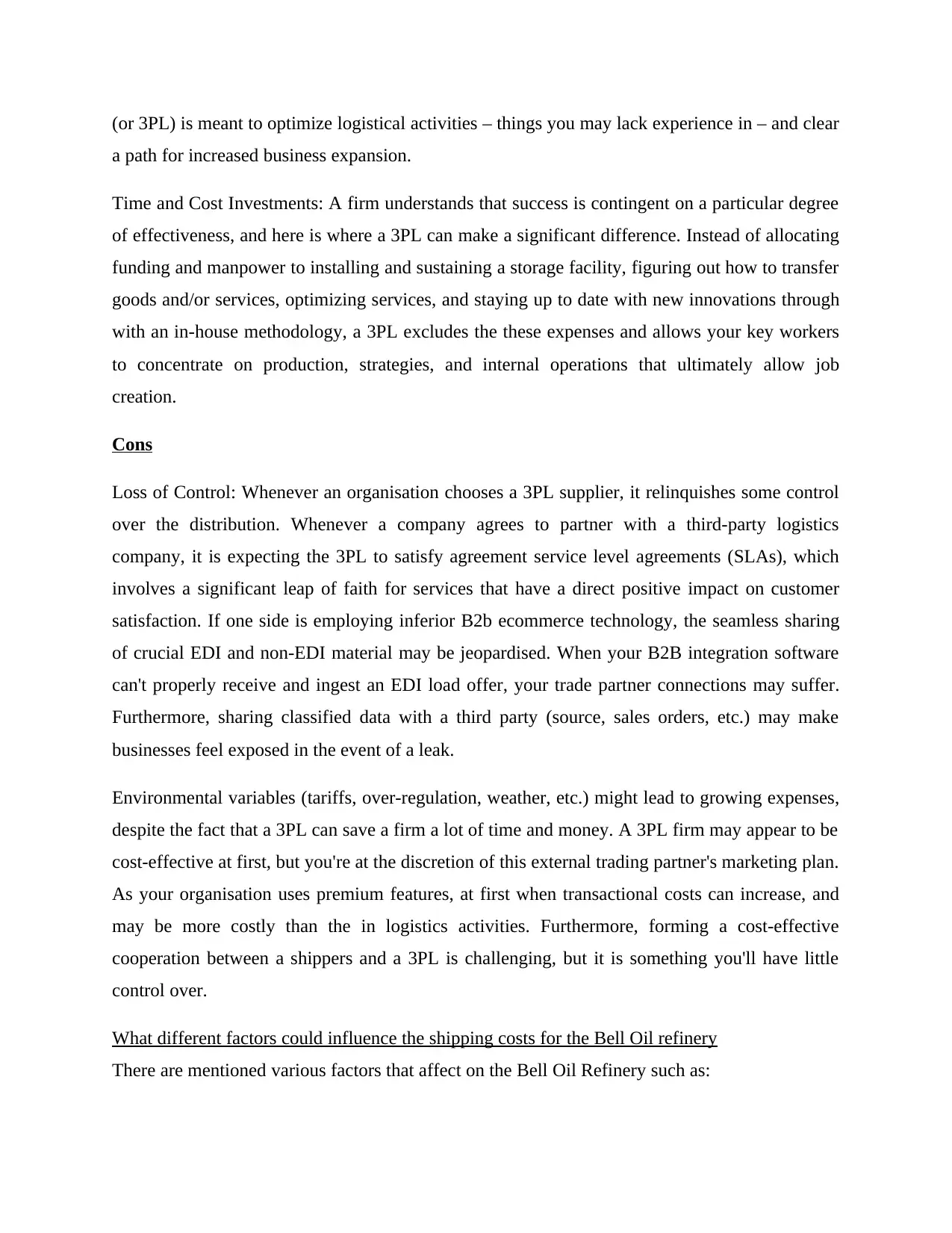
(or 3PL) is meant to optimize logistical activities – things you may lack experience in – and clear
a path for increased business expansion.
Time and Cost Investments: A firm understands that success is contingent on a particular degree
of effectiveness, and here is where a 3PL can make a significant difference. Instead of allocating
funding and manpower to installing and sustaining a storage facility, figuring out how to transfer
goods and/or services, optimizing services, and staying up to date with new innovations through
with an in-house methodology, a 3PL excludes the these expenses and allows your key workers
to concentrate on production, strategies, and internal operations that ultimately allow job
creation.
Cons
Loss of Control: Whenever an organisation chooses a 3PL supplier, it relinquishes some control
over the distribution. Whenever a company agrees to partner with a third-party logistics
company, it is expecting the 3PL to satisfy agreement service level agreements (SLAs), which
involves a significant leap of faith for services that have a direct positive impact on customer
satisfaction. If one side is employing inferior B2b ecommerce technology, the seamless sharing
of crucial EDI and non-EDI material may be jeopardised. When your B2B integration software
can't properly receive and ingest an EDI load offer, your trade partner connections may suffer.
Furthermore, sharing classified data with a third party (source, sales orders, etc.) may make
businesses feel exposed in the event of a leak.
Environmental variables (tariffs, over-regulation, weather, etc.) might lead to growing expenses,
despite the fact that a 3PL can save a firm a lot of time and money. A 3PL firm may appear to be
cost-effective at first, but you're at the discretion of this external trading partner's marketing plan.
As your organisation uses premium features, at first when transactional costs can increase, and
may be more costly than the in logistics activities. Furthermore, forming a cost-effective
cooperation between a shippers and a 3PL is challenging, but it is something you'll have little
control over.
What different factors could influence the shipping costs for the Bell Oil refinery
There are mentioned various factors that affect on the Bell Oil Refinery such as:
a path for increased business expansion.
Time and Cost Investments: A firm understands that success is contingent on a particular degree
of effectiveness, and here is where a 3PL can make a significant difference. Instead of allocating
funding and manpower to installing and sustaining a storage facility, figuring out how to transfer
goods and/or services, optimizing services, and staying up to date with new innovations through
with an in-house methodology, a 3PL excludes the these expenses and allows your key workers
to concentrate on production, strategies, and internal operations that ultimately allow job
creation.
Cons
Loss of Control: Whenever an organisation chooses a 3PL supplier, it relinquishes some control
over the distribution. Whenever a company agrees to partner with a third-party logistics
company, it is expecting the 3PL to satisfy agreement service level agreements (SLAs), which
involves a significant leap of faith for services that have a direct positive impact on customer
satisfaction. If one side is employing inferior B2b ecommerce technology, the seamless sharing
of crucial EDI and non-EDI material may be jeopardised. When your B2B integration software
can't properly receive and ingest an EDI load offer, your trade partner connections may suffer.
Furthermore, sharing classified data with a third party (source, sales orders, etc.) may make
businesses feel exposed in the event of a leak.
Environmental variables (tariffs, over-regulation, weather, etc.) might lead to growing expenses,
despite the fact that a 3PL can save a firm a lot of time and money. A 3PL firm may appear to be
cost-effective at first, but you're at the discretion of this external trading partner's marketing plan.
As your organisation uses premium features, at first when transactional costs can increase, and
may be more costly than the in logistics activities. Furthermore, forming a cost-effective
cooperation between a shippers and a 3PL is challenging, but it is something you'll have little
control over.
What different factors could influence the shipping costs for the Bell Oil refinery
There are mentioned various factors that affect on the Bell Oil Refinery such as:
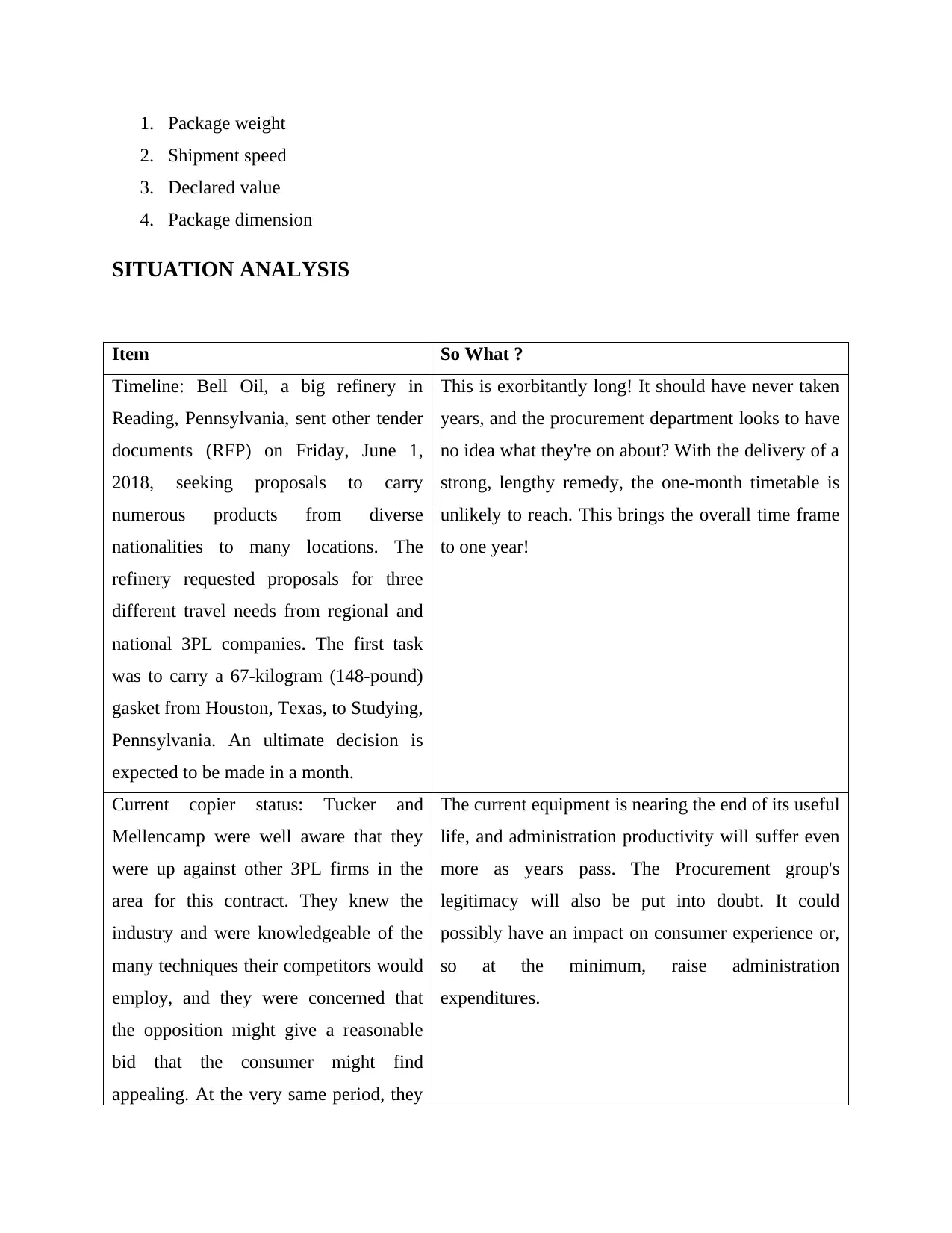
1. Package weight
2. Shipment speed
3. Declared value
4. Package dimension
SITUATION ANALYSIS
Item So What ?
Timeline: Bell Oil, a big refinery in
Reading, Pennsylvania, sent other tender
documents (RFP) on Friday, June 1,
2018, seeking proposals to carry
numerous products from diverse
nationalities to many locations. The
refinery requested proposals for three
different travel needs from regional and
national 3PL companies. The first task
was to carry a 67-kilogram (148-pound)
gasket from Houston, Texas, to Studying,
Pennsylvania. An ultimate decision is
expected to be made in a month.
This is exorbitantly long! It should have never taken
years, and the procurement department looks to have
no idea what they're on about? With the delivery of a
strong, lengthy remedy, the one-month timetable is
unlikely to reach. This brings the overall time frame
to one year!
Current copier status: Tucker and
Mellencamp were well aware that they
were up against other 3PL firms in the
area for this contract. They knew the
industry and were knowledgeable of the
many techniques their competitors would
employ, and they were concerned that
the opposition might give a reasonable
bid that the consumer might find
appealing. At the very same period, they
The current equipment is nearing the end of its useful
life, and administration productivity will suffer even
more as years pass. The Procurement group's
legitimacy will also be put into doubt. It could
possibly have an impact on consumer experience or,
so at the minimum, raise administration
expenditures.
2. Shipment speed
3. Declared value
4. Package dimension
SITUATION ANALYSIS
Item So What ?
Timeline: Bell Oil, a big refinery in
Reading, Pennsylvania, sent other tender
documents (RFP) on Friday, June 1,
2018, seeking proposals to carry
numerous products from diverse
nationalities to many locations. The
refinery requested proposals for three
different travel needs from regional and
national 3PL companies. The first task
was to carry a 67-kilogram (148-pound)
gasket from Houston, Texas, to Studying,
Pennsylvania. An ultimate decision is
expected to be made in a month.
This is exorbitantly long! It should have never taken
years, and the procurement department looks to have
no idea what they're on about? With the delivery of a
strong, lengthy remedy, the one-month timetable is
unlikely to reach. This brings the overall time frame
to one year!
Current copier status: Tucker and
Mellencamp were well aware that they
were up against other 3PL firms in the
area for this contract. They knew the
industry and were knowledgeable of the
many techniques their competitors would
employ, and they were concerned that
the opposition might give a reasonable
bid that the consumer might find
appealing. At the very same period, they
The current equipment is nearing the end of its useful
life, and administration productivity will suffer even
more as years pass. The Procurement group's
legitimacy will also be put into doubt. It could
possibly have an impact on consumer experience or,
so at the minimum, raise administration
expenditures.
⊘ This is a preview!⊘
Do you want full access?
Subscribe today to unlock all pages.

Trusted by 1+ million students worldwide
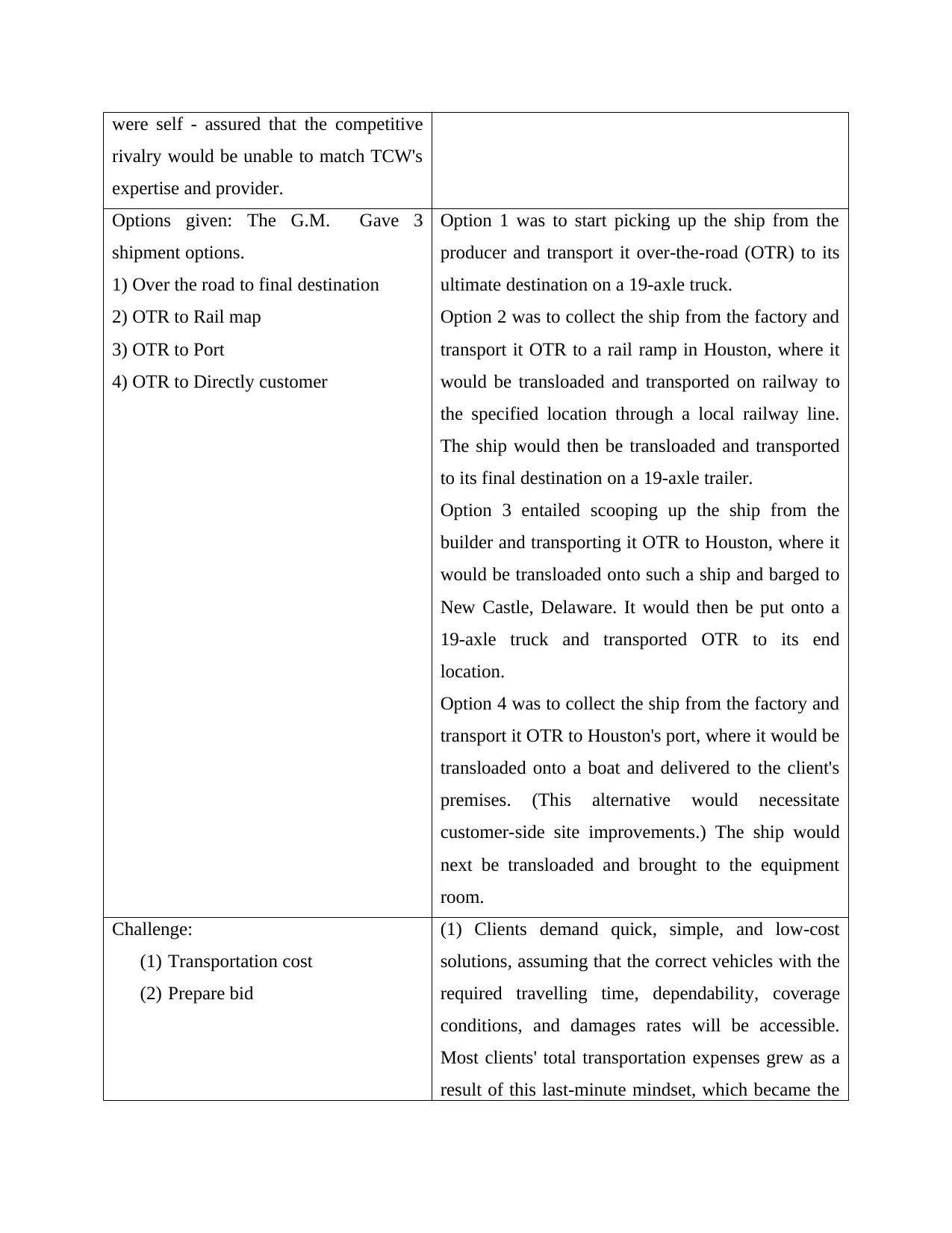
were self - assured that the competitive
rivalry would be unable to match TCW's
expertise and provider.
Options given: The G.M. Gave 3
shipment options.
1) Over the road to final destination
2) OTR to Rail map
3) OTR to Port
4) OTR to Directly customer
Option 1 was to start picking up the ship from the
producer and transport it over-the-road (OTR) to its
ultimate destination on a 19-axle truck.
Option 2 was to collect the ship from the factory and
transport it OTR to a rail ramp in Houston, where it
would be transloaded and transported on railway to
the specified location through a local railway line.
The ship would then be transloaded and transported
to its final destination on a 19-axle trailer.
Option 3 entailed scooping up the ship from the
builder and transporting it OTR to Houston, where it
would be transloaded onto such a ship and barged to
New Castle, Delaware. It would then be put onto a
19-axle truck and transported OTR to its end
location.
Option 4 was to collect the ship from the factory and
transport it OTR to Houston's port, where it would be
transloaded onto a boat and delivered to the client's
premises. (This alternative would necessitate
customer-side site improvements.) The ship would
next be transloaded and brought to the equipment
room.
Challenge:
(1) Transportation cost
(2) Prepare bid
(1) Clients demand quick, simple, and low-cost
solutions, assuming that the correct vehicles with the
required travelling time, dependability, coverage
conditions, and damages rates will be accessible.
Most clients' total transportation expenses grew as a
result of this last-minute mindset, which became the
rivalry would be unable to match TCW's
expertise and provider.
Options given: The G.M. Gave 3
shipment options.
1) Over the road to final destination
2) OTR to Rail map
3) OTR to Port
4) OTR to Directly customer
Option 1 was to start picking up the ship from the
producer and transport it over-the-road (OTR) to its
ultimate destination on a 19-axle truck.
Option 2 was to collect the ship from the factory and
transport it OTR to a rail ramp in Houston, where it
would be transloaded and transported on railway to
the specified location through a local railway line.
The ship would then be transloaded and transported
to its final destination on a 19-axle trailer.
Option 3 entailed scooping up the ship from the
builder and transporting it OTR to Houston, where it
would be transloaded onto such a ship and barged to
New Castle, Delaware. It would then be put onto a
19-axle truck and transported OTR to its end
location.
Option 4 was to collect the ship from the factory and
transport it OTR to Houston's port, where it would be
transloaded onto a boat and delivered to the client's
premises. (This alternative would necessitate
customer-side site improvements.) The ship would
next be transloaded and brought to the equipment
room.
Challenge:
(1) Transportation cost
(2) Prepare bid
(1) Clients demand quick, simple, and low-cost
solutions, assuming that the correct vehicles with the
required travelling time, dependability, coverage
conditions, and damages rates will be accessible.
Most clients' total transportation expenses grew as a
result of this last-minute mindset, which became the
Paraphrase This Document
Need a fresh take? Get an instant paraphrase of this document with our AI Paraphraser
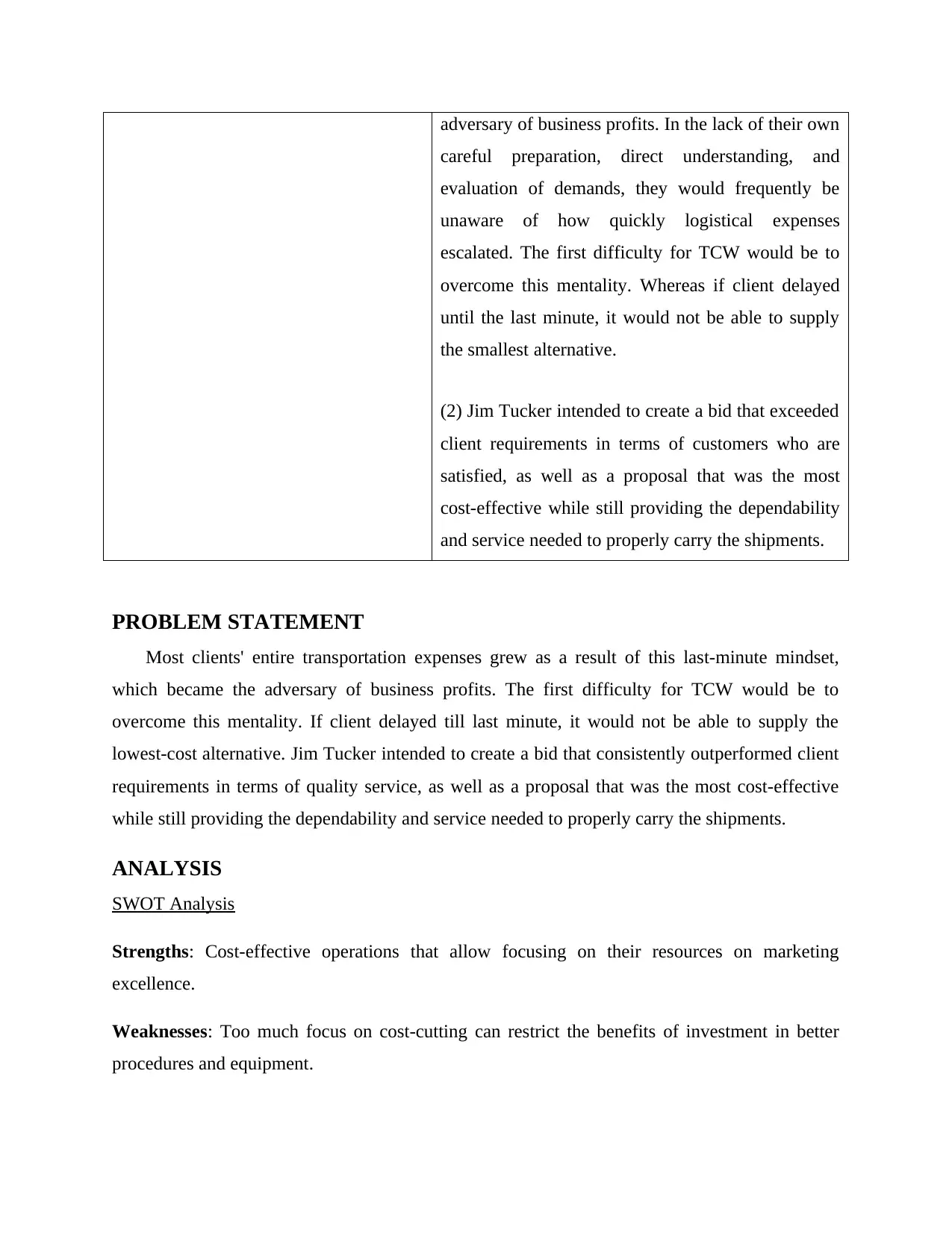
adversary of business profits. In the lack of their own
careful preparation, direct understanding, and
evaluation of demands, they would frequently be
unaware of how quickly logistical expenses
escalated. The first difficulty for TCW would be to
overcome this mentality. Whereas if client delayed
until the last minute, it would not be able to supply
the smallest alternative.
(2) Jim Tucker intended to create a bid that exceeded
client requirements in terms of customers who are
satisfied, as well as a proposal that was the most
cost-effective while still providing the dependability
and service needed to properly carry the shipments.
PROBLEM STATEMENT
Most clients' entire transportation expenses grew as a result of this last-minute mindset,
which became the adversary of business profits. The first difficulty for TCW would be to
overcome this mentality. If client delayed till last minute, it would not be able to supply the
lowest-cost alternative. Jim Tucker intended to create a bid that consistently outperformed client
requirements in terms of quality service, as well as a proposal that was the most cost-effective
while still providing the dependability and service needed to properly carry the shipments.
ANALYSIS
SWOT Analysis
Strengths: Cost-effective operations that allow focusing on their resources on marketing
excellence.
Weaknesses: Too much focus on cost-cutting can restrict the benefits of investment in better
procedures and equipment.
careful preparation, direct understanding, and
evaluation of demands, they would frequently be
unaware of how quickly logistical expenses
escalated. The first difficulty for TCW would be to
overcome this mentality. Whereas if client delayed
until the last minute, it would not be able to supply
the smallest alternative.
(2) Jim Tucker intended to create a bid that exceeded
client requirements in terms of customers who are
satisfied, as well as a proposal that was the most
cost-effective while still providing the dependability
and service needed to properly carry the shipments.
PROBLEM STATEMENT
Most clients' entire transportation expenses grew as a result of this last-minute mindset,
which became the adversary of business profits. The first difficulty for TCW would be to
overcome this mentality. If client delayed till last minute, it would not be able to supply the
lowest-cost alternative. Jim Tucker intended to create a bid that consistently outperformed client
requirements in terms of quality service, as well as a proposal that was the most cost-effective
while still providing the dependability and service needed to properly carry the shipments.
ANALYSIS
SWOT Analysis
Strengths: Cost-effective operations that allow focusing on their resources on marketing
excellence.
Weaknesses: Too much focus on cost-cutting can restrict the benefits of investment in better
procedures and equipment.
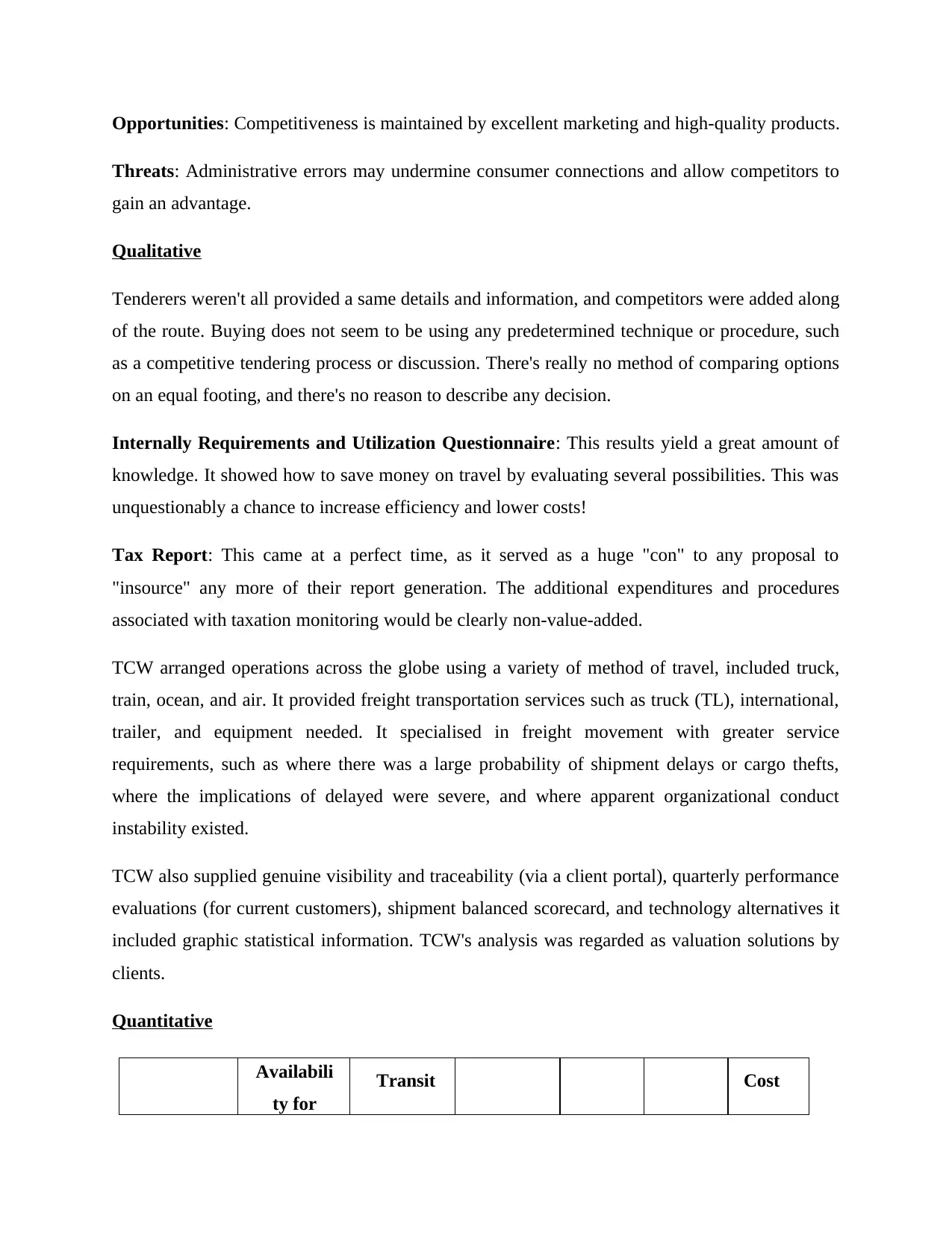
Opportunities: Competitiveness is maintained by excellent marketing and high-quality products.
Threats: Administrative errors may undermine consumer connections and allow competitors to
gain an advantage.
Qualitative
Tenderers weren't all provided a same details and information, and competitors were added along
of the route. Buying does not seem to be using any predetermined technique or procedure, such
as a competitive tendering process or discussion. There's really no method of comparing options
on an equal footing, and there's no reason to describe any decision.
Internally Requirements and Utilization Questionnaire: This results yield a great amount of
knowledge. It showed how to save money on travel by evaluating several possibilities. This was
unquestionably a chance to increase efficiency and lower costs!
Tax Report: This came at a perfect time, as it served as a huge "con" to any proposal to
"insource" any more of their report generation. The additional expenditures and procedures
associated with taxation monitoring would be clearly non-value-added.
TCW arranged operations across the globe using a variety of method of travel, included truck,
train, ocean, and air. It provided freight transportation services such as truck (TL), international,
trailer, and equipment needed. It specialised in freight movement with greater service
requirements, such as where there was a large probability of shipment delays or cargo thefts,
where the implications of delayed were severe, and where apparent organizational conduct
instability existed.
TCW also supplied genuine visibility and traceability (via a client portal), quarterly performance
evaluations (for current customers), shipment balanced scorecard, and technology alternatives it
included graphic statistical information. TCW's analysis was regarded as valuation solutions by
clients.
Quantitative
Availabili
ty for
Transit Cost
Threats: Administrative errors may undermine consumer connections and allow competitors to
gain an advantage.
Qualitative
Tenderers weren't all provided a same details and information, and competitors were added along
of the route. Buying does not seem to be using any predetermined technique or procedure, such
as a competitive tendering process or discussion. There's really no method of comparing options
on an equal footing, and there's no reason to describe any decision.
Internally Requirements and Utilization Questionnaire: This results yield a great amount of
knowledge. It showed how to save money on travel by evaluating several possibilities. This was
unquestionably a chance to increase efficiency and lower costs!
Tax Report: This came at a perfect time, as it served as a huge "con" to any proposal to
"insource" any more of their report generation. The additional expenditures and procedures
associated with taxation monitoring would be clearly non-value-added.
TCW arranged operations across the globe using a variety of method of travel, included truck,
train, ocean, and air. It provided freight transportation services such as truck (TL), international,
trailer, and equipment needed. It specialised in freight movement with greater service
requirements, such as where there was a large probability of shipment delays or cargo thefts,
where the implications of delayed were severe, and where apparent organizational conduct
instability existed.
TCW also supplied genuine visibility and traceability (via a client portal), quarterly performance
evaluations (for current customers), shipment balanced scorecard, and technology alternatives it
included graphic statistical information. TCW's analysis was regarded as valuation solutions by
clients.
Quantitative
Availabili
ty for
Transit Cost
⊘ This is a preview!⊘
Do you want full access?
Subscribe today to unlock all pages.

Trusted by 1+ million students worldwide
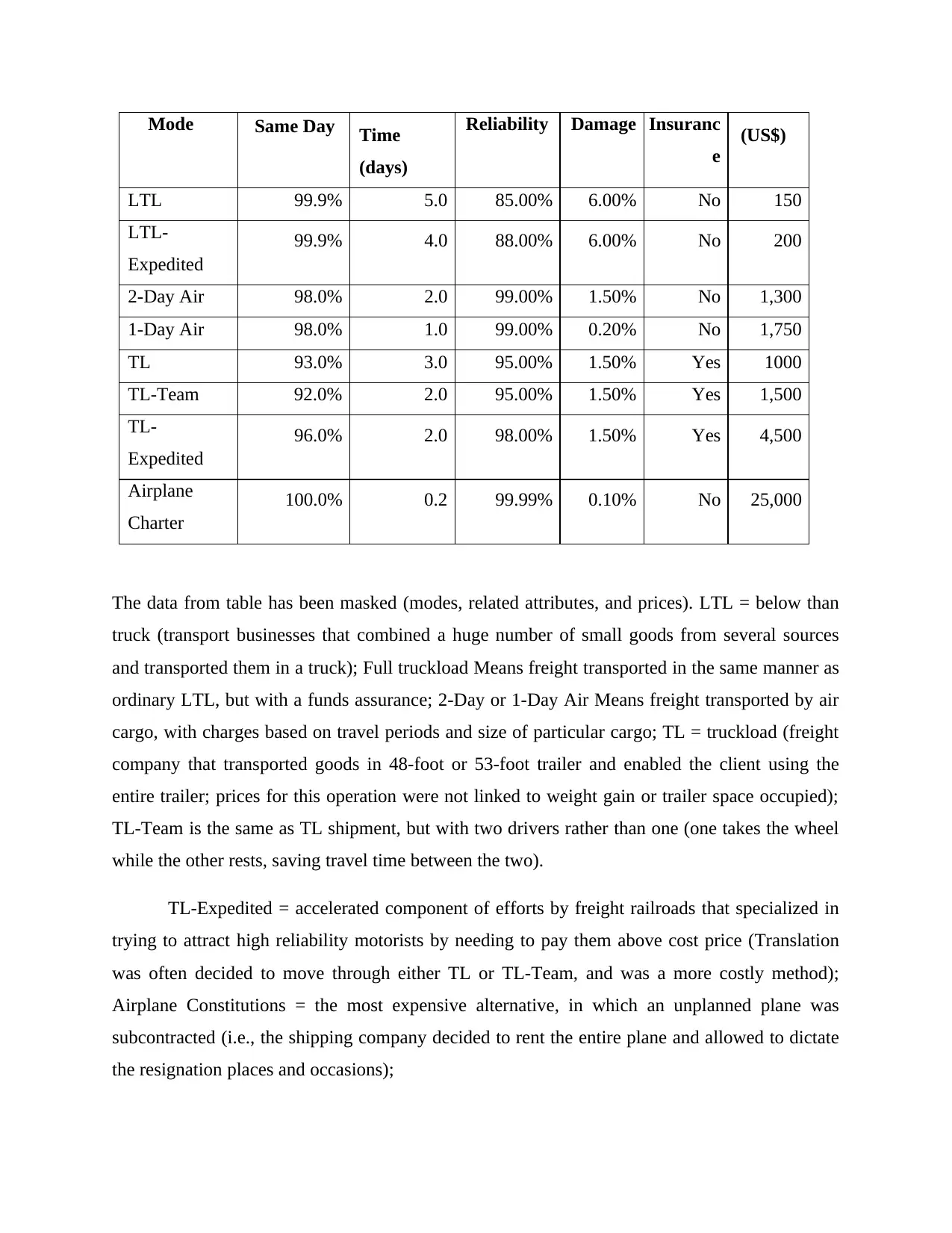
Mode Same Day Time
(days)
Reliability Damage Insuranc
e
(US$)
LTL 99.9% 5.0 85.00% 6.00% No 150
LTL-
Expedited
99.9% 4.0 88.00% 6.00% No 200
2-Day Air 98.0% 2.0 99.00% 1.50% No 1,300
1-Day Air 98.0% 1.0 99.00% 0.20% No 1,750
TL 93.0% 3.0 95.00% 1.50% Yes 1000
TL-Team 92.0% 2.0 95.00% 1.50% Yes 1,500
TL-
Expedited
96.0% 2.0 98.00% 1.50% Yes 4,500
Airplane
Charter
100.0% 0.2 99.99% 0.10% No 25,000
The data from table has been masked (modes, related attributes, and prices). LTL = below than
truck (transport businesses that combined a huge number of small goods from several sources
and transported them in a truck); Full truckload Means freight transported in the same manner as
ordinary LTL, but with a funds assurance; 2-Day or 1-Day Air Means freight transported by air
cargo, with charges based on travel periods and size of particular cargo; TL = truckload (freight
company that transported goods in 48-foot or 53-foot trailer and enabled the client using the
entire trailer; prices for this operation were not linked to weight gain or trailer space occupied);
TL-Team is the same as TL shipment, but with two drivers rather than one (one takes the wheel
while the other rests, saving travel time between the two).
TL-Expedited = accelerated component of efforts by freight railroads that specialized in
trying to attract high reliability motorists by needing to pay them above cost price (Translation
was often decided to move through either TL or TL-Team, and was a more costly method);
Airplane Constitutions = the most expensive alternative, in which an unplanned plane was
subcontracted (i.e., the shipping company decided to rent the entire plane and allowed to dictate
the resignation places and occasions);
(days)
Reliability Damage Insuranc
e
(US$)
LTL 99.9% 5.0 85.00% 6.00% No 150
LTL-
Expedited
99.9% 4.0 88.00% 6.00% No 200
2-Day Air 98.0% 2.0 99.00% 1.50% No 1,300
1-Day Air 98.0% 1.0 99.00% 0.20% No 1,750
TL 93.0% 3.0 95.00% 1.50% Yes 1000
TL-Team 92.0% 2.0 95.00% 1.50% Yes 1,500
TL-
Expedited
96.0% 2.0 98.00% 1.50% Yes 4,500
Airplane
Charter
100.0% 0.2 99.99% 0.10% No 25,000
The data from table has been masked (modes, related attributes, and prices). LTL = below than
truck (transport businesses that combined a huge number of small goods from several sources
and transported them in a truck); Full truckload Means freight transported in the same manner as
ordinary LTL, but with a funds assurance; 2-Day or 1-Day Air Means freight transported by air
cargo, with charges based on travel periods and size of particular cargo; TL = truckload (freight
company that transported goods in 48-foot or 53-foot trailer and enabled the client using the
entire trailer; prices for this operation were not linked to weight gain or trailer space occupied);
TL-Team is the same as TL shipment, but with two drivers rather than one (one takes the wheel
while the other rests, saving travel time between the two).
TL-Expedited = accelerated component of efforts by freight railroads that specialized in
trying to attract high reliability motorists by needing to pay them above cost price (Translation
was often decided to move through either TL or TL-Team, and was a more costly method);
Airplane Constitutions = the most expensive alternative, in which an unplanned plane was
subcontracted (i.e., the shipping company decided to rent the entire plane and allowed to dictate
the resignation places and occasions);
Paraphrase This Document
Need a fresh take? Get an instant paraphrase of this document with our AI Paraphraser
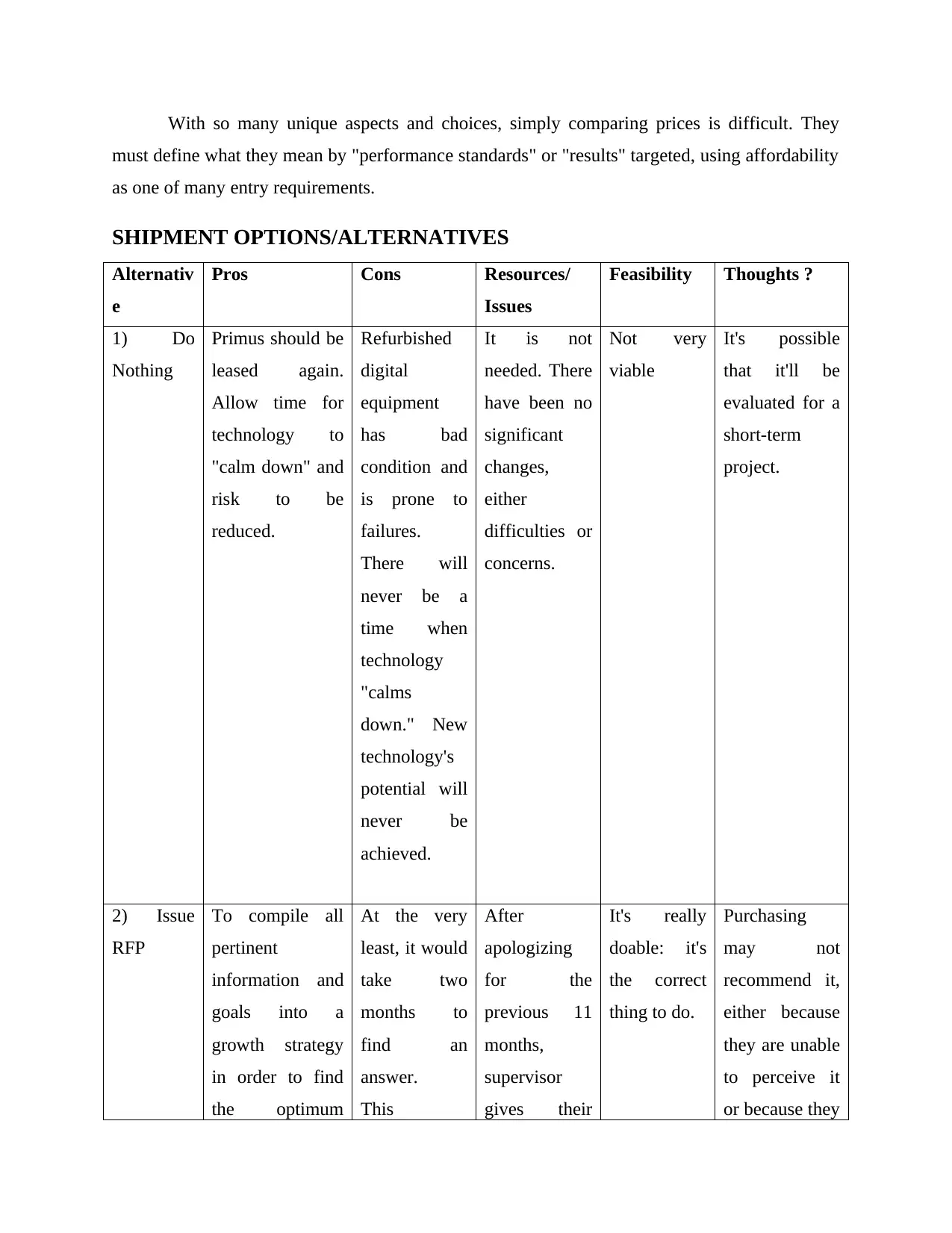
With so many unique aspects and choices, simply comparing prices is difficult. They
must define what they mean by "performance standards" or "results" targeted, using affordability
as one of many entry requirements.
SHIPMENT OPTIONS/ALTERNATIVES
Alternativ
e
Pros Cons Resources/
Issues
Feasibility Thoughts ?
1) Do
Nothing
Primus should be
leased again.
Allow time for
technology to
"calm down" and
risk to be
reduced.
Refurbished
digital
equipment
has bad
condition and
is prone to
failures.
There will
never be a
time when
technology
"calms
down." New
technology's
potential will
never be
achieved.
It is not
needed. There
have been no
significant
changes,
either
difficulties or
concerns.
Not very
viable
It's possible
that it'll be
evaluated for a
short-term
project.
2) Issue
RFP
To compile all
pertinent
information and
goals into a
growth strategy
in order to find
the optimum
At the very
least, it would
take two
months to
find an
answer.
This
After
apologizing
for the
previous 11
months,
supervisor
gives their
It's really
doable: it's
the correct
thing to do.
Purchasing
may not
recommend it,
either because
they are unable
to perceive it
or because they
must define what they mean by "performance standards" or "results" targeted, using affordability
as one of many entry requirements.
SHIPMENT OPTIONS/ALTERNATIVES
Alternativ
e
Pros Cons Resources/
Issues
Feasibility Thoughts ?
1) Do
Nothing
Primus should be
leased again.
Allow time for
technology to
"calm down" and
risk to be
reduced.
Refurbished
digital
equipment
has bad
condition and
is prone to
failures.
There will
never be a
time when
technology
"calms
down." New
technology's
potential will
never be
achieved.
It is not
needed. There
have been no
significant
changes,
either
difficulties or
concerns.
Not very
viable
It's possible
that it'll be
evaluated for a
short-term
project.
2) Issue
RFP
To compile all
pertinent
information and
goals into a
growth strategy
in order to find
the optimum
At the very
least, it would
take two
months to
find an
answer.
This
After
apologizing
for the
previous 11
months,
supervisor
gives their
It's really
doable: it's
the correct
thing to do.
Purchasing
may not
recommend it,
either because
they are unable
to perceive it
or because they
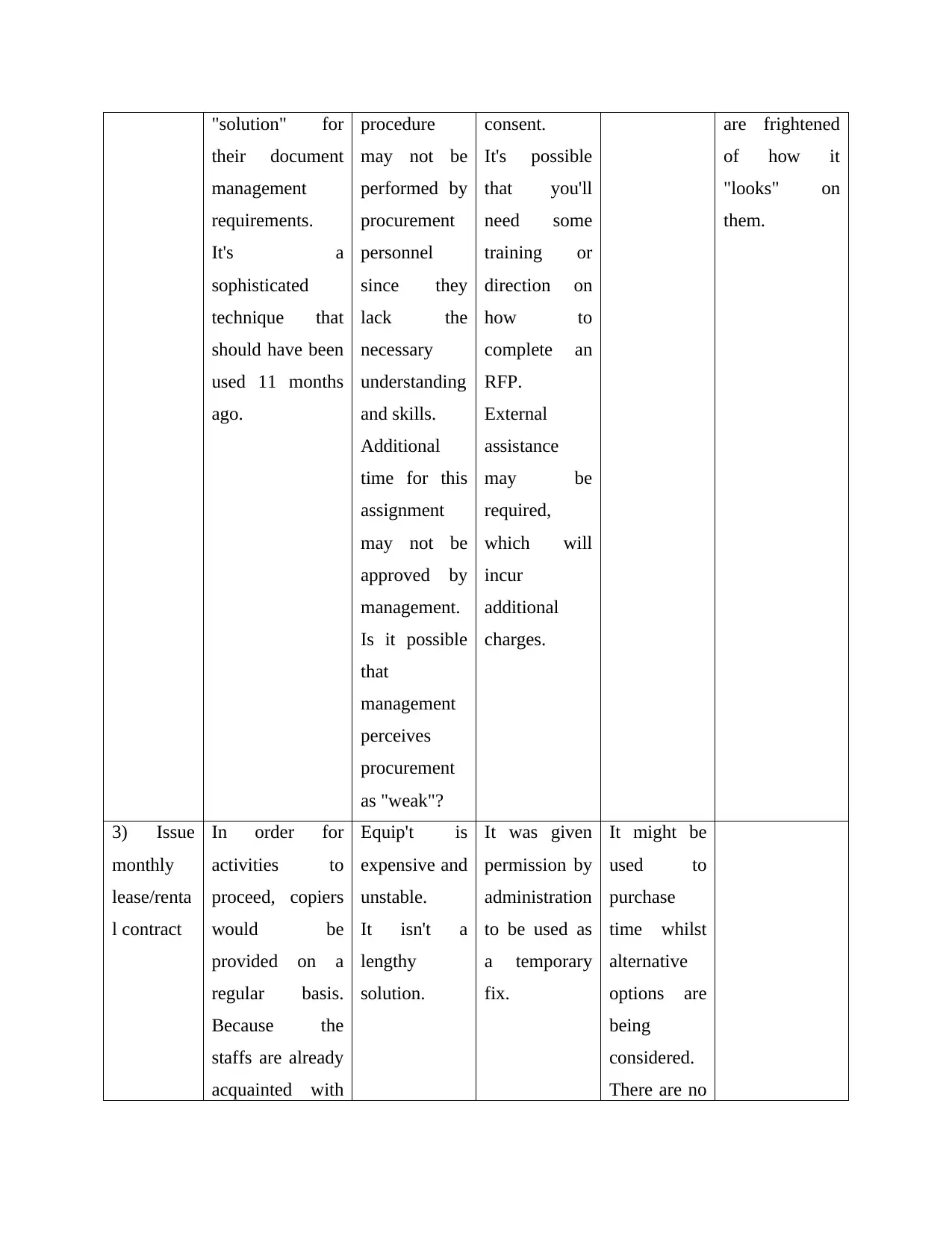
"solution" for
their document
management
requirements.
It's a
sophisticated
technique that
should have been
used 11 months
ago.
procedure
may not be
performed by
procurement
personnel
since they
lack the
necessary
understanding
and skills.
Additional
time for this
assignment
may not be
approved by
management.
Is it possible
that
management
perceives
procurement
as "weak"?
consent.
It's possible
that you'll
need some
training or
direction on
how to
complete an
RFP.
External
assistance
may be
required,
which will
incur
additional
charges.
are frightened
of how it
"looks" on
them.
3) Issue
monthly
lease/renta
l contract
In order for
activities to
proceed, copiers
would be
provided on a
regular basis.
Because the
staffs are already
acquainted with
Equip't is
expensive and
unstable.
It isn't a
lengthy
solution.
It was given
permission by
administration
to be used as
a temporary
fix.
It might be
used to
purchase
time whilst
alternative
options are
being
considered.
There are no
their document
management
requirements.
It's a
sophisticated
technique that
should have been
used 11 months
ago.
procedure
may not be
performed by
procurement
personnel
since they
lack the
necessary
understanding
and skills.
Additional
time for this
assignment
may not be
approved by
management.
Is it possible
that
management
perceives
procurement
as "weak"?
consent.
It's possible
that you'll
need some
training or
direction on
how to
complete an
RFP.
External
assistance
may be
required,
which will
incur
additional
charges.
are frightened
of how it
"looks" on
them.
3) Issue
monthly
lease/renta
l contract
In order for
activities to
proceed, copiers
would be
provided on a
regular basis.
Because the
staffs are already
acquainted with
Equip't is
expensive and
unstable.
It isn't a
lengthy
solution.
It was given
permission by
administration
to be used as
a temporary
fix.
It might be
used to
purchase
time whilst
alternative
options are
being
considered.
There are no
⊘ This is a preview!⊘
Do you want full access?
Subscribe today to unlock all pages.

Trusted by 1+ million students worldwide
1 out of 17
Your All-in-One AI-Powered Toolkit for Academic Success.
+13062052269
info@desklib.com
Available 24*7 on WhatsApp / Email
![[object Object]](/_next/static/media/star-bottom.7253800d.svg)
Unlock your academic potential
Copyright © 2020–2025 A2Z Services. All Rights Reserved. Developed and managed by ZUCOL.
